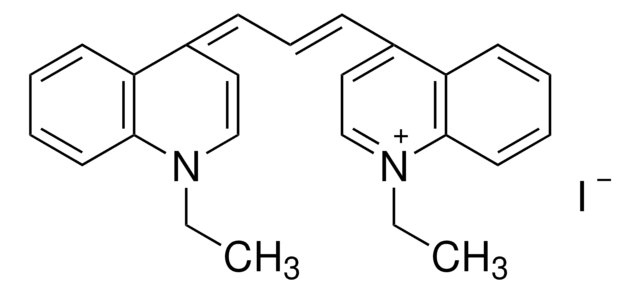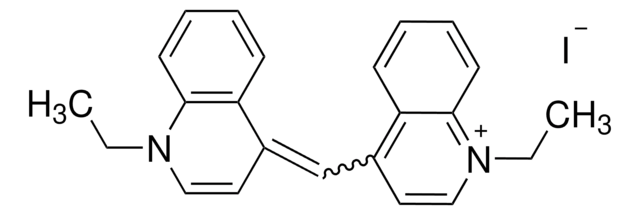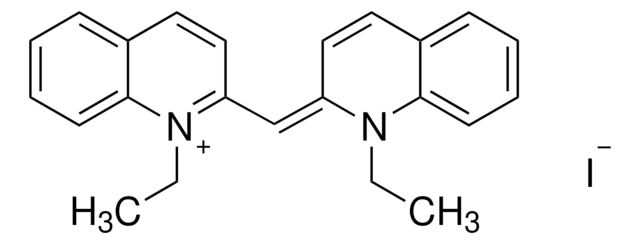389919
3,3′-Diethylthiatricarbocyanine perchlorate
99%
Synonym(s):
DTTC perchlorate
About This Item
Recommended Products
Assay
99%
mp
184 °C (dec.) (lit.)
λmax
760 nm
SMILES string
[O-]Cl(=O)(=O)=O.CCN1\C(Sc2ccccc12)=C\C=C\C=C\C=C\c3sc4ccccc4[n+]3CC
InChI
1S/C25H25N2S2.ClHO4/c1-3-26-20-14-10-12-16-22(20)28-24(26)18-8-6-5-7-9-19-25-27(4-2)21-15-11-13-17-23(21)29-25;2-1(3,4)5/h5-19H,3-4H2,1-2H3;(H,2,3,4,5)/q+1;/p-1
InChI key
PZQHZVAROUTGBU-UHFFFAOYSA-M
Application
Signal Word
Warning
Hazard Statements
Precautionary Statements
Hazard Classifications
Eye Irrit. 2 - Skin Irrit. 2 - STOT SE 3
Target Organs
Respiratory system
Storage Class Code
11 - Combustible Solids
WGK
WGK 3
Flash Point(F)
Not applicable
Flash Point(C)
Not applicable
Personal Protective Equipment
Regulatory Listings
Regulatory Listings are mainly provided for chemical products. Only limited information can be provided here for non-chemical products. No entry means none of the components are listed. It is the user’s obligation to ensure the safe and legal use of the product.
JAN Code
389919-VAR:
389919-BULK:
389919-500MG:
389919-100MG:
Choose from one of the most recent versions:
Certificates of Analysis (COA)
Don't see the Right Version?
If you require a particular version, you can look up a specific certificate by the Lot or Batch number.
Already Own This Product?
Find documentation for the products that you have recently purchased in the Document Library.
Customers Also Viewed
Articles
Graphene has emerged as the new wonder material. Being only one atom thick and composed of carbon atoms arranged in a hexagonal honeycomb lattice structure, the interest in this material has exploded exponentially since 2004 when it was first isolated and identified using a very simple method.
Our team of scientists has experience in all areas of research including Life Science, Material Science, Chemical Synthesis, Chromatography, Analytical and many others.
Contact Technical Service











